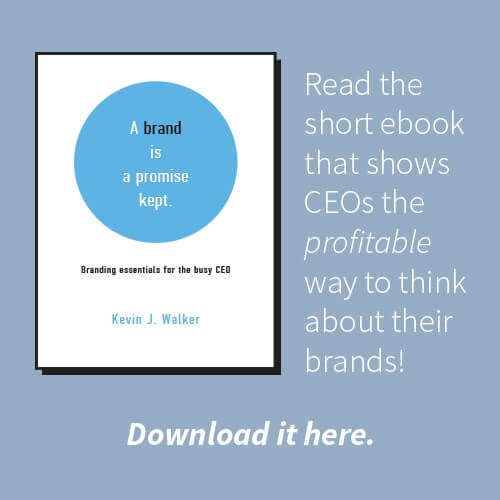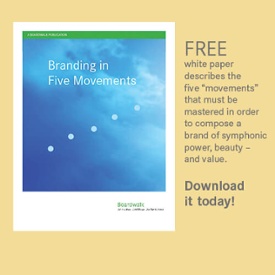 I was recently invited to submit an outline for a publication entitled “5 things you need to do to create a believable, trusted and beloved brand”. The invitation quoted Seth Godin as defining a brand as “an implicit promise”. I think Mr. Godin has it about right – mmm, almost. And that's the problem with these kinds of queries. Everyone will be basing their submissions on a different definition of brand. There is no definition of "brand" that is universally accepted. But the whole exercise sounds like fun so I’m going to submit anyway. My five steps are at the end of this article. But we’ll have to start with my definition of what a brand is because that’s what informs my five points. I tell all my clients to memorize these six words: “A brand is a promise kept.” I tell them that’s the most profitable way that they could define the term when thinking about their brands. You have to know what your brand promise is. You have to communicate that promise to your market. And you have to keep your promise. To see how it works, let’s first parse the sentence.
I was recently invited to submit an outline for a publication entitled “5 things you need to do to create a believable, trusted and beloved brand”. The invitation quoted Seth Godin as defining a brand as “an implicit promise”. I think Mr. Godin has it about right – mmm, almost. And that's the problem with these kinds of queries. Everyone will be basing their submissions on a different definition of brand. There is no definition of "brand" that is universally accepted. But the whole exercise sounds like fun so I’m going to submit anyway. My five steps are at the end of this article. But we’ll have to start with my definition of what a brand is because that’s what informs my five points. I tell all my clients to memorize these six words: “A brand is a promise kept.” I tell them that’s the most profitable way that they could define the term when thinking about their brands. You have to know what your brand promise is. You have to communicate that promise to your market. And you have to keep your promise. To see how it works, let’s first parse the sentence.
A BRAND …
Here you have to put on your strategic thinking cap and define your brand promise. You have to figure out how you’re going to position your business. You have to do a thorough, objective analysis of your market and define your place within it. You have to figure out the purpose your market has for you. Dig deep. Your purpose is not just to be your customers’ supplier of widgets. What is their motivation for buying widgets from you and not from your competitors’? What does it say about your customers that they buy widgets from you? Figure that out and you’ll begin to understand your true competitive advantage – your true brand promise. There are actually eight characteristics of a strong brand promise. Chief among them: it needs to be proprietary. Your brand promise should be something no one else can match. Let’s say, after doing all this research and analysis you discover that people buy your widgets because they feel smart for having done so. Not cool – not safe, tech-savvy or frugal – smart.
… IS A PROMISE …
Now you have to make that brand promise to your market. This is all your storytelling. Whenever you make an explicit advertising promise, e.g. “Big widget sale this Saturday” make sure you also make the brand promise implicit, e.g. “Our widgets are for really smart people”. Show your widget in settings, or with people, your audience will associate with wisdom. Your advertising promise will always be changing but your brand promise, if it’s well-conceived, should last you 15-20 years. Make your brand promise consistently over those years – and be just as consistent across all media. Whether in content marketing,
Ask Boardwalk to discover your brand’s
most competitive positioning.
on outdoor billboards or even in skywriting, always make the same brand promise. All your market communication, including your visual identity and other non-verbal cues, should be designed to support your brand promise.
… KEPT.
This part is left out of most definitions of brand – but it’s critical! If you don’t deliver on it, your brand promise is worthless. As an owner or manager of a marketable asset, keeping the brand promise should be your primary, daily concern. You have to be obsessed with delivering widgets that make people feel smart. Remember, they can buy widgets anywhere – but your research has shown they can only get that feeling of smartness from you. Deliver that!
The three segments of the sentence each relate to different parts of your business. The first segment, “A Brand”, is strategy. The second, “is a Promise”, is marketing. And the third, “Kept”, is operations. So we can see that it takes the entire company to build the brand. Everyone, from board room to mail room, should be able to see how their specific job function contributes to making widget buyers feel smarter. Keeping the brand promise is essential because of another way of defining “brand”. A brand is a relationship. It is the relationship between a marketable asset and its market. If you know, with certainty, what your brand promise is, and if you make that brand promise consistently, over time, your market will begin to reward you with brand loyalty. They’ll come back to you again and again without even a glance toward your competition. The brand grows in that covenant. The market gets their widgets, plus the emotional benefit of feeling smart. The business gets a monetary reward. Everyone benefits. The stronger the relationship between the two parties, the stronger, and more valuable, the brand. Again, a brand is a promise kept. If you make the right brand promise to your market, if you communicate it consistently and if you always – always – deliver on it, you will build a great brand.
Keeping the brand promise is essential because of another way of defining “brand”. A brand is a relationship. It is the relationship between a marketable asset and its market. If you know, with certainty, what your brand promise is, and if you make that brand promise consistently, over time, your market will begin to reward you with brand loyalty. They’ll come back to you again and again without even a glance toward your competition. The brand grows in that covenant. The market gets their widgets, plus the emotional benefit of feeling smart. The business gets a monetary reward. Everyone benefits. The stronger the relationship between the two parties, the stronger, and more valuable, the brand. Again, a brand is a promise kept. If you make the right brand promise to your market, if you communicate it consistently and if you always – always – deliver on it, you will build a great brand.
So how to build a brand in five “easy” steps?
1 – Know your market. Not just your customers but every constituency whose perception of your brand is important to its future. That includes, employees, prospective employees, suppliers, vendors, financiers, the press – everybody. You want one brand promise that will energize them all.
2 – Determine your brand promise. Do an objective deep dive into your current business. Survey your competitive environment. What is the one thing you can offer that no one else can? How will you position your brand for competitive advantage?
3 – Communicate your brand promise. Communicate as frequently as you can and make your brand promise consistently.
4 – Deliver on your brand promise. Always. Without fail.
5 – Remember the brand is a shared relationship with your market. That relationship is the most important business asset you have and the only one that appreciates in value over time. It’s like a marriage. Don’t neglect it and don’t for a minute think that you own it. A brand is a promise kept.
Best Branding Reads – Week of July 15
Retail Startup Bulletin Raises $7 Million Series to Build a Platform That Connects Brands With Stores
Retail is dying? No. It’s transforming.
The Strategy Behind Successful Brand Names
Excellent article. Author knows his stuff.
Exploding Experience Expectations – a ‘Triple Ex…Threat’?
Key takeaway: People don’t measure a brand against its competition. They measure it against what’s possible.
How Brands Can Support The Pursuit Of Happiness
It would be a worthwhile and interesting exercise to consider how YOUR brand can make people happy. If not directly, then indirectly through supporting causes, etc.
Metro Tackles Fake News by Redesigning Captcha
Here’s an example of a brand doing something really worthwhile.
Let's Fix All The Bird Logos In Pro Sports
I might be the only person to enjoy this article. But then I like logos, sports AND birds.
Influencer marketing spend grows 83%
No matter how poor the ROI, brands can’t stop spending on influencers.



